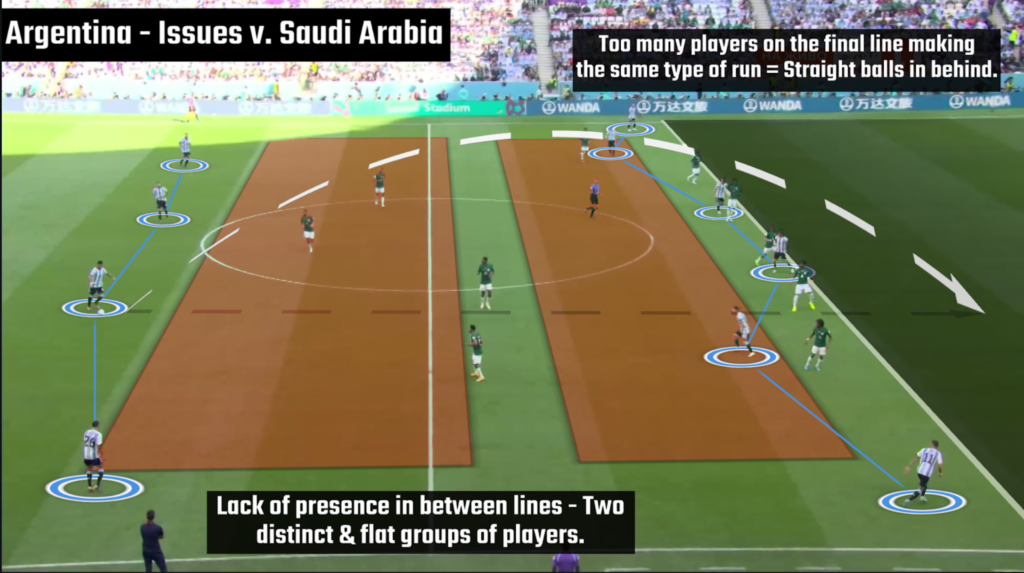We are currently in the early stages of the knockout rounds of the World Cup, with all the drama and storylines you’d expect from the greatest football tournament on earth. With all these narrative-driven viewpoints flying around, there has been a ton of interesting things to look at from a tactical & analysis perspective. Whether it be individual performances, coaches getting it right (or wrong) with their tactics, great defensive or attacking matches, etc. – The World Cup has been full of it.
While some of the early matches in the tournament have been seemingly the victim of the draining Qatari heat (apart from Serbia v Cameroon), and goals down on average across the board, this piece will take a look at some of the highlights from the analysis standpoint. Taking a look at four things I found interesting, and presenting my own perspective on what went well, what went poorly, and presenting some hypothetical fixes I would tell the coaching staff should I be thrust into the same scenario (obviously with the benefit of hindsight!)
Argentina v. Saudi Arabia – Playing Past The High Line
The first major shock of the tournament came on the third day. Argentina, for many the favourites to win it all, came unstuck against Herve Renard’s Saudi Arabian side. However, it was not through the Saudi’s adopting an outright defensive approach which saw them win the game. Yes, the two goals might have been their only major chances of the match, but their defensive posture (a 4-1-4-1 mid-block) played with a very high line that left tons of space in behind for Argentina. Due to a lack of efficiency from an Argentina perspective though (taking nothing away from Saudi Arabia’s bravery/tactics) they were unable to take advantage.
What The Match Looked Like
Rather than sitting deep in a line of 5 & allowing Argentina to keep the ball on the edge of their box in a compact block, Saudi Arabia, as highlighted above, played in an aggressive 4-1-4-1 with an incredibly high line. Obviously, this leads space in behind for a team to attack but due to the structure of Scaloni’s team, they were unable to capitalise.
On Argentina’s side of the ball, they played a 4-2-3-1 but were unable to exploit the aforementioned high line due to how they positioned themselves: Paredes dropped down in the build-up play to allow the ball-carrying CB to progress the ball without direct pressure on him. As a consequence, however, the other midfielders in possession were positioned too high – Providing them with an inability to switch play, which meant everything Argentina did was vertical – Leading to straight balls over the top which were easy to deny with an offside trap (and a bit of luck!). On top of that, the advanced position in the attacking lines meant that Saudi Arabia could easily close the half-spaces in front of the back four. Further issues arose in Argentina’s frustration when midfielders, in an attempt to get on the ball dropped even further into the defensive lines alongside the defenders – Meaning that it was essentially two lines of players they had.
How To Fix It
Whilst Saudi Arabia defended in a unique fashion compared to what Argentina have faced since, Scaloni and his staff have implemented a number of the hypothetical fixes presented here. For one, against a high line, the best type of pass to utilise are diagonal passes over the top, rather than straight on. These types of angles are tougher to collectively defend as a unit & allow attackers more flexibility in the types of runs they make. Against Saudi Arabia in particular, the best positions for runners to attack are the areas between the full & centre back – Specifically on the weak side so runs can be made across the blind side. In order to stretch the Saudi lines (and give Argentine attackers more room) it would be imperative that the winger held width, rather than inverting inside to clog space.
Finally, by having better staggering in midfield & not constantly having your players drop out of the pockets of space centrally you can create more dilemmas for Saudi once they are broken through – Once you have broken the lines (which Argentine players are certainly capable of doing!) You have attackers positioned in advanced areas where you can slip them on & attack the depth. After all, shorter passes of 10 yards on the ground are easier to play than 50 yard diagonals. These two fixes, in healthy doses together, would provide various threats and could have fixed the issues seen in this match.
USA v. England – Breaking Down A 4-4-2
In the second group game of Group B, England played the United States (a match which caused quite the dilemma for me personally). From my biassed perspective, the change from Gregg Berhalter and his staff to play a 4-4-2 mid-block and prevent progression was fun to watch – It also gave them two forwards up top: i.e. more ability to play forward and generate transitional opportunities themselves. However, the inability for England to break down this (on the surface) relatively basic defence could have been fixed by a few alterations on the ball.
How the US pressed:
The video below describes and illustrates what the United States did on their end. Normally defending in a 4-3-3 throughout qualifying & in the opener against Wales, they shifted to a 4-4-2 out of possession against English – Both as a protective switch and as mentioned previously, to create transitions. Haji Wright & Timothy Weah were the two forwards, Pulisic dropped down to the left, and West McKennie (normally central on the right). To negate the extra man in midfield, the two forwards pivoted down depending on the ball-side to cover the pivot player for England (normally Rice), and pressed with their wingers aggressively whenever it was played to the full backs. England’s attack was stunted for the vast majority of the match and had the U.S. executed/played better final balls on the counter, it could have been a costly defeat.
How To Fix It:
Knowing the style of play England want to try and impose, as an analyst, I would propose massive formation/stylistic changes – Rather, small shifts in terms of positioning of individual players or alterations to intent. Here are a few:
While the midfield lines of the United States were compact and tough to play through vertically via the centre backs – And the press allowed the US to keep England at arm’s length this way, one of the major disadvantages to it is how flat it can be, especially behind the forwards and midfield. Rice, often occupying these deeper spaces could (and needed) to make himself more of a threat in these second phases of play – Popping up between lines to add an option once the full back received it, rather than that pass becoming a dead zone out wide.
Secondly, the positioning of the advanced central midfielders for England could have been better. Oftentimes, in their frustration, the likes of Bellingham & Mount would drop off into redundant areas – Once again playing into the hands of the United States. In these areas (alongside Rice covered by the two forwards), Adams & Musah could become man-oriented and further make playing centrally more difficult. By starting higher initially and staying higher until the right moments, it would provide a dilemma for the U.S. and drop off their midfield lines more than they were in the match – Further creating space for the pass to the full back, playing past the cover shadow up front, etc. The distances would be too great at certain times for the pressure they enacted. Combined with Harry Kane dropping off the line, the wingers inverting inside the lines, etc. England could have created +1s in dangerous positions of the pitch.
Finally, the final piece to the jigsaw is be braver on the ball from the outright with centre backs who seek to engage and provoke pressure, rather than simply complete a basic “checklist” whilst on the ball (look forward, look to full back, look to centre back square in that order). Combined with the previously mentioned fixes to England’s dilemmas, this would force the United State shape to be less rigid than it was in the game. By driving forward with the ball, with more intent, the spaces between forwards (covering the central areas well) would be increased, & combinations such as third man runs would be maximised.
USA v. Netherlands
Another USA game, which I will not apologise for! In this match, Louis Van Gaal and his coaching staff took an incredibly reactive approach to the match, and ceded possession to Gregg Berhalter & his players. In doing so, they took the US players out of their element & forced them to become protagonists of the attacking play of the match, and forced two of their worst ball-players to be the ones facilitating it.
How the Dutch Defended:
As shown from the video above, the Netherlands defended in a 3-5-2 and dropped their line of confrontation (when they started pressing the ball) at the halfway line. Their front two players, Cody Gakpo & Memphis Depay, split & allowed the US centre backs, Tim Ream & Walker Zimmerman all the time in the world on the ball. Instead, they shadowed the full backs & denied them access to the ball, acting as a funnel inside. From here, the central midfield were marked 3v3/man-to-man – Any pass from the centre backs (who were not comfortable on the ball in the first place) were forced into players who had immediate pressure on the ball, were facing their own goal, etc. Ahead of the ball, the US were relatively static as well, leading to an inability to play beyond/over the top to bypass this press (See the Argentina v. Saudi Arabia game).
How To Fix It:
The first way, which is relatively team/specific & not necessarily creative, would be to switch to a back three – Allowing the US to go 3v2 against the two forwards’ “pressure.” Alongside the simple numerical advantages it would provide, the spacing between three central defenders creates more issues. Rather than the funnel forcing Ream & Zimmerman inside every time, the additional player would allow them to quickly switch play beyond/around the funnel & drive into pockets of space, or access the full back.
If they elected to stay within the system, there are two ways to create from the build: One via short passing variations, and the other playing over the press. The short passing alteration I would suggest is to trust the ability of the midfield, and create third man situations through the full back – Ream/Zimmerman drive with the ball, find a midfielder, who plays a bounce pass out wide to access full back. This pass could have been supported by the wide players for the US pinning the Dutch wing backs (who were the ones given freedom to jump the ball normally). Any time they played “deliberate” passes (i.e. point A to point B), the Dutch were clever to it.
Secondly, the long pass (which in turn, forces the Dutch lines to drop off & creates more space for the centre backs to access) would require some simple countermovements to find – Similar to a goal the US scored against Morocco a number of months back. With Ferreira at the #9, who has a natural desire to drop off and combine, the Dutch defenders would track him & become man-oriented. This, of course, leaves a space vacated – A space that one of the wingers could attack and provide a threat in behind. These countermovements when Ferreira did drop off were non-existent. Both these hypothetical fixes presented are not perfect due to the personnel that were on the pitch, but providing various solutions to the Dutch defensive organisation, you minimise the risk you have playing out.
Croatia v. Canada – Game Management
Canada managed to reach their first World Cup since 1986 through a distinctive style of play, alongside the considerable talent they have at their disposal. Throughout CONCACAF qualifying, their games followed a distinct pattern: Come out strong/aggressive, take the lead, and then sit deep/stay compact, and force teams to try and break them down – their chances coming via the considerable talents in transition of Alphonso Davies, Richie Larerya, Tajon Buchanan, and more.
What Happened
Against Croatia in what was a must win game, they scored within minutes – Part 1 of their blueprint achieved. However they remained aggressive throughout the first half and seeked to press the Croatians. While a front-footed approach on the surface which sought to continue to press the advantage they held in the match (at the time), the ability of the midfield trio was too great to overcome against a shorthanded (3v2) Canadian side. As well, this front footed approach highlighted the weaknesses at the back for Canada.
Defending in a 4-4-2, Canada sought to perform a similar job that the US did against England in the same shape – However, against Canada, the likes of Brozovic, Kovacic, and Modric were much more clever in tight spaces & performing the same sort of “fixes” I suggested England take up. On top of that, they utilised rotations ahead of the ball to overload the double pivot & make use of the stretched lines to generate quick line breaks into the final third. Why was this successful? For one, Eustaquio on one side of the midfield was completely overworked – Atiba Hutchinson is 39 years old: Counting on essentially one player to do the running of three for full 90 (especially when you have a talent deficit) is unwise. Secondly, while Canada are a team who like to run in wide areas on their turns, but forced two centre backs who are much more comfortable defending their area/box, to cover the opposition at speed – Leaving them isolated 1v1, pulled into the channels, etc.
How To Save Canada
Outside of a simple fix of mentality – Not going gung-ho when the game state is in your favour, Doing everything in their power to match-up the Croatian midfield & transition in the space they vacate (in other words, what Canada have been good at), would be my suggestion. Rather than engaging the midfield directly, play with an extra midfielder & go 4-1-4-1 – Allow the legs in that midfield (Eustaquio) to sweep up danger between the lines and screen/protect the midfield of the pitch. In doing so, you would invite Croatia onto you but rather than behind/through you they are forced to play in front.
With this platform, you can negate a lot of the individual quality deficits you have (as is the case with plenty of deep block) & protect your legs – I’m sure Atiba Hutchinson would be thankful. As well, this sets up Canada to do exactly what they did throughout qualification: Counter-attack. Croatia are slow at the back themselves, and with the likes of David, Davies, Buchanan, etc. with space in front of them, there is a ton of potential to add to that league in a controlled manner. Simply put, rather than going away from a strategy that got you there, lean into it even harder.










